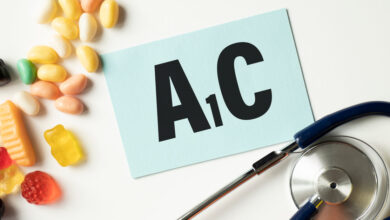Is the Albumin Creatinine Ratio (ACR) important in diabetes?

The Albumin Creatinine Ratio (ACR) test result is the ratio of measured albumin (a protein) and creatinine (a metabolism by-product) in the urine that has been excreted from the body, at the time of the test.
The ACR and Its Importance in Diabetes
The severity of Albumin Creatinine Ratio levels, or albuminuria as we often call it, is indicated as microalbuminuria and macro-albuminuria. These indicate whether a person is likely to have early kidney disease. Very high levels are an indication that kidney disease is present in a more severe form. Normo-albuminuria, on the other hand, is an indication that there is no kidney damage.
ACR is reported as either normal, micro or macro-albuminuria:
- Normal levels: Males < 2.5 mg/mmol (<22 mg/g) Females < 3.5 mg/mmol (< 30 mg/g).
- Microalbuminuria: Males 2.5 to 25 mg/mmol (22 to 220 mg/g) Females 3.5 to 35 mg/mmol (30 to 300 mg/g).
- Macroalbuminuria: Males > 25 mg/mmol (> 220 mg/g) Females > 35 mg/mmol (>300 mg/g).
It is recommended that it is mandatory for all people with diabetes to have an annual assessment of micro-albuminuria (ACR) to test for early signs of kidney damage. If abnormal, this test needs to be repeated to confirm it is abnormal as having kidney damage has ramifications in diabetes.
If you have diabetes, it is very important to know whether or not you have micro-albuminuria. This Albumin Creatinine Ratio is a risk factor for cardiovascular and kidney disease. In other words, your risk of developing complications is not exclusively linked to your blood glucose level. It is important that you are involved in your care and know your numbers.
Other factors, such as your ACR, are just as important:
- Eyes. Retinopathy increases the risk of renal failure (1).
- Feet. Neuropathy increases the risk of retinopathy and heart disease (2).
- Kidneys. The ACR reflects nephropathy which increases the risk of Coronary Artery Disease and Cerebro-vascular Disease (3) (4).
- Heart Disease increases the risk of stroke and dementia.
- Peri-odontal disease increases the risk of heart and kidney disease (5).
The take home message for you is that if you have one complication, then chances are you either already have or will develop another. You and your doctor need to be on the lookout for complications and their associated risk factors. Prevent one and you will prevent another. Albumin Creatinine Ratio test results do not independently confirm a specific diagnosis. You must consult with your doctor. Normally, we need to repeat the test and you need to have 2 abnormal results before we can make a diagnosis. Also, we need to repeat the test at least annually. And keep in mind that limitations do exist. In addition to chronic kidney disease, factors such as urinary tract infections, high protein dietary intake, or heavy exercise 24 hrs before the test are known to affect Albumin Creatinine Ratio results.
What is the Target ACR for Well Controlled Diabetes?
- You need an Albumin Creatinine Ratio of < 2.5 mg/mmol (<22 mg/g) for males and < 3.5 mg/mmol (< 30 mg/g) for females.
- You need to have this Albumin Creatinine Ratio test done annually if in range and more frequently if you are not on target.
Who can help you manage your ACR?
Your GP can offer you monitoring, feedback, support, referrals (e.g. to a nephrologist) and optimise medications where necessary. You need to know your Albumin Creatinine Ratio, achieve target HbA1c and control your blood pressure. Work with your GP and diabetes team and be involved in your own care. Most success is achieved with structured care approach.
Conclusion: Understanding ACR in Diabetes
- The Albumin Creatinine Ratio test result is the ratio of measured albumin (a protein) and creatinine (a metabolism by-product) in the urine.
- Albumin Creatinine Ratio is reported as either normal, micro or macro-albuminuria.
- The ACR indicate whether you are likely to have early kidney disease.
- This ACR is a risk factor for cardiovascular and kidney disease independent of blood glucose.
- 2 abnormal results are needed before a diagnosis can be made.
- The ACR needs to be measured at least once a year.
- Target ACR of < 2.5 mg/mmol (<22 mg/g) for males and < 3.5 mg/mmol (< 30 mg/g) for females.
- Control blood pressure, blood glucose and don’t smoke to protect the kidneys.



